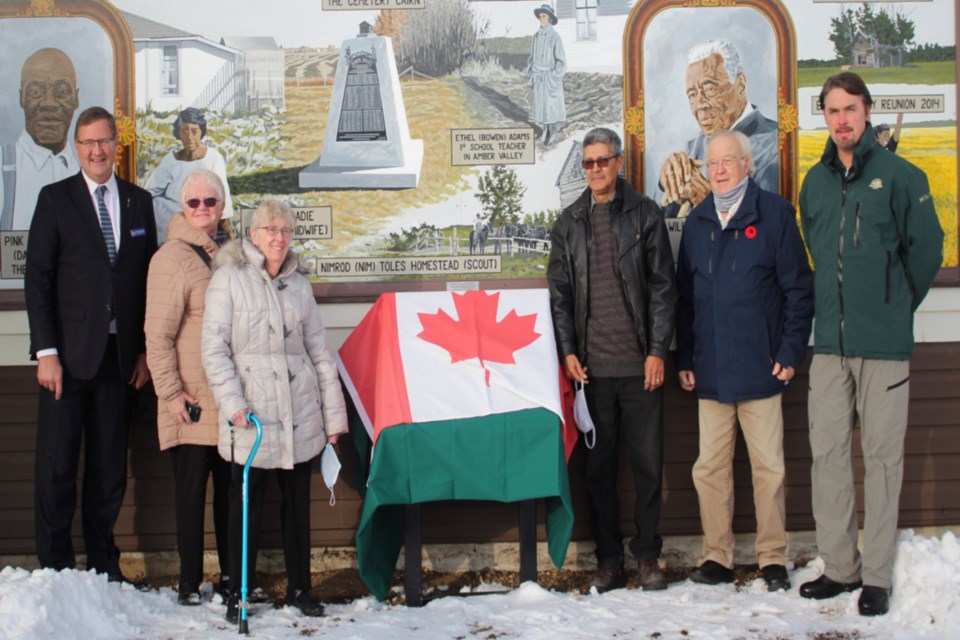ATHABASCA - A plaque commemorating the Black settlers of the Athabasca region is back on display, but in its new home at the Amber Valley Community Hall.
The plaque gives a nod to those African American settlers who arrived in the area from the United States between 1908 and 1911, and the situation they found themselves in upon their move. The plaque was originally placed at a historical roadside turnout east of the Town of Athabasca on Highway 55, but went missing this spring, much to the concern of the Amber Valley Community Association (AVCA) who had just installed the plaque in 2017, after a 12-year battle with Ottawa.
The plaque was subsequently found, damaged and dirty, in the Emcon yard in Athabasca, after it was knocked over by a snow plow. The society then petitioned the Historic Sites and Monuments Board of Canada (HSMB) with the assistance of Parks Canada - Elk Island supervisor Dale Kirkland to relocate the plaque from its previous location to outside Amber Valley Hall. The unveiling took place at a subdued gathering of officials at the hall Nov. 15.
“My role behind the scenes was to work with our national office colleagues in Ottawa-Gatineau who involve themselves in HSMB plaques to ensure that we got the approval for relocation from the highway to the hall as quickly as we could,” said Kirkland. “So, I leaned and pushed gently just to make sure that would happen.”
Knowing it had taken Myrna Wisdom years of constant petitioning to get the plaque in the first place, the society was once again expecting a drawn-out process, but with help from the Town of Athabasca, Athabasca County, Athabasca Library Archives and Kirkland they received the approval in October.
“I’d like to take this opportunity to thank, in particular, Colleen Powell, mayor of Athabasca, Larry Armfelt, Athabasca County reeve and Margaret Anderson from the Athabasca Archives,” said AVCA president Gil Williams. “These groups provided letters of support for us to approach the Historic Sites and Monuments Board, which is part of Parks Canada, and asking to support our request to relocate this commemorative plaque.”
Once approved, Parks Canada in Elk Island collected the plaque, cleaned it up, repaired and installed it, all in less than two weeks, explained Kirkland, saying they picked it up Oct. 8 and installed it Oct. 21.
“We got the plaque in our hands; my staff took the plaque back down to Elk Island and in our shops there we rebuilt the base, rebuilt the legs a wee bit, cleaned it up really nice, made sure there's no other damages to the text plaque itself,” said Kirkland. “And then from there, our staff came back and a lot of staff were here with augers and cement and made that nice little area and prepared it and the plaque was installed.”
Athabasca-Barrhead-Westlock MLA Glenn van Dijken read congratulations from Culture, Multiculturalism and Status of Women Minister Leela Aheer, and noted that growing up in the County of Barrhead, he was unaware until he was an adult of a Black settlement near Campsie on Highway 18 towards Thunder Lake.
"I believe that it's really important now that we have this history shared and it continues to be brought out in classrooms through generations so that the next generations can also recognize what built the province and those people that came before us,” he said. “So, thank you very much for all the work that goes into ensuring that the history stays alive.”
In both English and French, the plaque reads:
Black Pioneer Immigration to Alberta and Saskatchewan
The arrival of over a thousand African Americans to this region between 1908 and 1911 marked the Dominion of Canada’s first experience with Black immigration en masse. It sparked a backlash in parts of the press and business community that led the federal government to adopt an unofficial policy of exclusion by race, limiting the number of Black people entering Canada until the 1960s. Nonetheless, these courageous settlers established their own institutions, created a rich social life, and forged vibrant farming communities largely in isolation from other groups and in keeping with what they had known in the United States.
Heather Stocking, TownandCountryToday.com
Follow me on Twitter @HLSox



